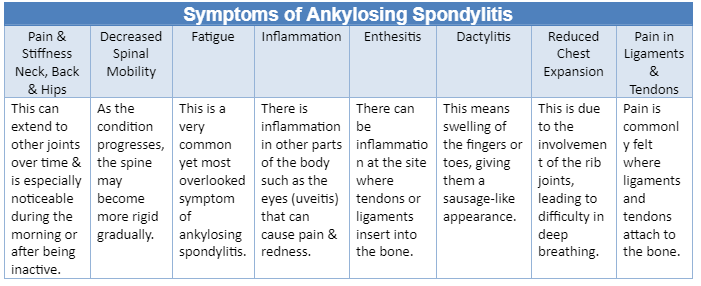
Ankylosing Spondylitis is a chronic inflammatory disease that mainly affects the lower back and hips. It's an ailment that silently develops and is often neglected as a simple backache by most people in the early stages. However, in reality, AS is a condition that can significantly impact the quality of life of young adults. In India, it affects 1 in every 100 young adults, with men being 2-3 times more susceptible than women. Typically diagnosed in individuals younger than 40, AS tends to show its first signs between 20 and 30 years of age. One of the most under-diagnosed conditions in India mainly due to lack of awareness, AS is often mistaken to be a “regular backache".
Synopsis
Symptoms of Ankylosing Spondylitis
The symptoms of ankylosing spondylitis can vary in intensity and may not be present in every person. If you notice any of these signs persistently, especially if you're a young adult, it's wise to seek medical consultation for a proper assessment and diagnosis.

When to Consult a Doctor for Ankylosing Spondylitis?
Recognizing when to seek medical attention for Ankylosing Spondylitis (AS) is a critical step in effectively managing and treating this condition. Here's when you should consider consulting an orthopedician in Bangalore
-
You have had persistent back pain and stiffness for more than 3 months.
-
You're a young adult experiencing symptoms of ankylosing spondylitis.
-
There’s a history of AS or other autoimmune diseases in your family.
-
The symptoms might become severe rapidly, causing difficulty in performing basic movements.
-
You notice other symptoms which can be warning signs of AS like eye inflammation (redness, pain, & sensitivity to light), unexplained fatigue, or pain in other joints.
Treatment for Ankylosing Spondylitis (AS)
Early treatment can prevent or slow down the structural damage progression caused by AS, preventing bone fusion and in many cases preventing new bone formation. Once the joints are damaged, patients would need joint replacement surgery.
Below are some common treatment options that treat mild to moderate Ankylosing Spondylitis:
-
Nonsteroidal Anti-Inflammatory Drugs (NSAIDs): As the first line of treatment used to treat mild AS, NSAIDs like ibuprofen and naproxen help reduce inflammation, pain, and stiffness.
-
Disease-Modifying Anti-Rheumatic Drugs (DMARDs): For cases where NSAIDs are not effective, DMARDs may be prescribed. They can help slow down the progression of AS and manage its symptoms.
-
Biologic Agents: Advanced treatment options include biologic agents, such as TNF blockers and IL-17 inhibitors. These work by targeting specific parts of the immune system.
-
Corticosteroids: These are used in limited scenarios for quick relief of inflammation. Corticosteroids are often administered via injection directly into the affected joint area.
-
Physical Therapy: It is a critical component for managing AS. Physical therapy helps maintain joint flexibility, improve posture, and strengthen muscles around the spine.
-
Pain Management Techniques: Techniques such as heat/cold therapy, acupuncture, or massage can provide additional relief.
-
Regular Monitoring and Follow-up: Regular check-ups with an orthopaedician are important to monitor the disease progression and adjust treatments as necessary.
Surgical Approaches for Treating Ankylosing Spondylitis
Surgical approaches to treat Ankylosing Spondylitis are considered when other conventional methods like medications and physical therapy are not effective in managing severe symptoms or when there is severe structural damage. Robot-assisted surgery represents a significant advancement in the surgical treatment of AS, particularly in joint replacement surgeries like Total Hip Replacements, Partial Knee, and Total Knee Replacements.
Consult our orthopaedic hospital in Bangalore if you need ankylosing spondylitis therapies
Why Opt for Robot-Assisted Joint Replacement Surgery?
Robot-assisted joint replacement surgery offers a huge advantage to patients and surgeons compared to traditional joint replacement methods. This state-of-the-art technology has transformed surgeries, particularly for conditions like Ankylosing Spondylitis (AS), where precision is key.
1. Enhanced Precision & Accuracy
Robot-assisted systems provide surgeons with a high degree of accuracy in placing implants. The robotic arm ensures that the implant is aligned and positioned in a way that closely matches the patient's natural anatomy.
2. Customized Surgical Planning
Before the surgery, 3D models of the patient's joints are created to pre-plan the procedure in detail. This allows for a highly personalized surgical plan based on the patient’s unique anatomy, leading to better outcomes. This prevents complications such as impingement and dislocations due to implant malposition.
3. Smaller Incisions & Reduced Tissue Trauma
Robotic surgery is a minimally invasive approach that requires smaller incisions than traditional surgery. This reduces damage to surrounding tissues, muscles, and bones.
4. Reduced Pain & Faster Recovery
Patients typically experience less pain post-surgery due to the minimally invasive nature of the procedure. This often translates into a faster recovery period and a quicker return to daily activities. Most patients can walk the very next day after robotic joint replacements with support and by 6 weeks post-surgery, they can walk comfortably without any aid with a near normal gait.
With proper care, most people with AS who undergo robotic joint replacement surgery experience significant improvement in their pain, stiffness, and mobility. The type of surgery needed depends on the severity of the joint damage and the affected joints. Feel free to consult one of the best robotic joint replacement surgeons in Bangalore for the best possible diagnosis and treatment.
FAQ's
The best ways to manage your AS include:
-
Staying active
-
Maintaining a healthy weight.
-
Quitting smoking
-
Getting enough sleep
-
Stress management
-
Regular check-ups with your doctor.
No, it’s an inflammatory disease that can cause irreversible damage to the spine and other joints and tissues. Early medical management is the best option.
The most common symptoms of AS include the following:
-
Pain and stiffness in the lower back, hips, and neck.
-
Difficulty bending and twisting.
-
Reduced range of motion.
-
Fatigue.



















 6 Min Read
6 Min Read















